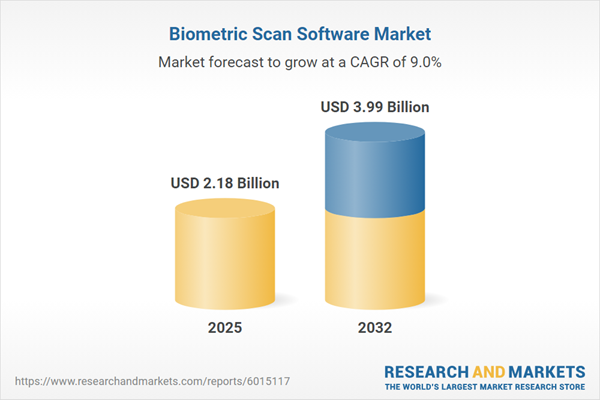Speak directly to the analyst to clarify any post sales queries you may have.
Biometric scan software is transforming enterprise security strategies, enabling organizations to modernize authentication approaches and proactively address operational and compliance complexities across digitally connected environments. Senior decision-makers benefit from rapidly evolving solutions that align with shifting global security and regulatory priorities.
Market Snapshot: Biometric Scan Software Market Size & Growth
The biometric scan software market is registering strong momentum, with revenues reaching USD 2 billion in 2024 and projected to grow to USD 2.18 billion by 2025. Long-term forecasts anticipate a market value of USD 3.99 billion by 2032, reflecting a compound annual growth rate (CAGR) of 8.96%.
This robust expansion is largely driven by enterprise investment in digital security, the growing use of biometric authentication for employee access, and intensified requirements to meet global regulatory standards. Healthcare, finance, and government are particularly active in adopting biometric scan technologies, ensuring security and compliance are integrated throughout institutional operations.Scope & Segmentation of the Biometric Scan Software Market
This report equips executive audiences with actionable, segmented insights to inform biometric software strategy, investment considerations, and technology selection as security challenges and risk profiles evolve globally.
- Technology Types: Facial recognition utilizing 2D, 3D, and thermal imaging methods; fingerprint scanning based on capacitive, optical, ultrasonic, and thermal sensors; iris detection through both near-infrared and visible spectrum techniques; vein and hand geometry analysis; voice recognition via text-dependent and text-independent protocols. Each enables multifactor authentication and underpins advanced policy controls.
- Applications: Secure access control, employee identity management, patient verification in healthcare environments, mobile payment authentication, enterprise workforce attendance tracking, and comprehensive surveillance for public sector use. These applications support both operational consistency and regulatory alignment.
- End Use Industries: Adoption is evident across banking and finance, government and defense, healthcare, IT and telecommunications, retail, e-commerce, and travel sectors. Organizations deploy these solutions to enhance regulatory compliance, secure sensitive infrastructure, and optimize core business workflows.
- Deployment Modes: Comparison of cloud-based and on-premises installations allows deployment planning that considers internal security policies, prevailing compliance standards, existing IT landscapes, and legacy integration support.
- Geographic Coverage: Evaluation of regional market drivers and policy trends covers the Americas, Europe, the Middle East & Africa, and Asia-Pacific. Strategic insights are delivered for the United States, Canada, Brazil, United Kingdom, Germany, China, India, Japan, and Australia to facilitate local adaptation and support global compliance.
- Key Market Players: Industry leadership is profiled through companies such as NEC Corporation, Thales S.A., IDEMIA France SAS, Suprema Inc., Aware, Inc., HID Global Corporation, Fingerprint Cards AB, Precise Biometrics AB, Daon Inc., and Bio-key International, Inc., illustrating their significant role in shaping technological advances and influencing adoption trajectories.
Key Takeaways for Senior Leaders
- Biometric scan software empowers organizations to implement authentication systems that can be adapted for sector-specific needs and changing regulatory environments.
- Integration of sophisticated algorithms and modern sensor technology improves the accuracy of user identification while maintaining convenience in high-traffic enterprise settings.
- Emphasis on privacy-by-design principles and advanced encryption increases stakeholder trust and assists organizations in meeting data protection mandates across borders.
- The emergence of edge computing and behavioral analytics enables responsive, real-time biometric security solutions that address complex operational scenarios.
- Enterprises are transitioning to modular and collaborative security platforms, which increase agility for managing regulatory variation and supporting long-term compliance strategies.
Tariff Impact: Navigating Supply Chain and Cost Pressures
Upcoming U.S. tariffs on imported biometric hardware, set for 2025, are prompting enterprises and solution providers to reconsider their supply chain and procurement strategies. Many are moving toward regional assembly to mitigate tariff exposure and are implementing more agile pricing models in hardware contracts. These proactive measures are designed to sustain procurement efficiency and enhance supply chain resilience amid a fluctuating global trade landscape.
Methodology & Data Sources
Findings in this report draw on a blend of secondary research from regulatory filings, patent databases, and corporate disclosures, complemented by firsthand interviews with market participants. Independent expert validation and a structured approach to data triangulation provide robust support for executive intelligence and decision-making.
Why This Report Matters
- Enables executive teams to select and adopt biometric technology that aligns with security policies and broader compliance objectives across the enterprise.
- Equips senior leadership to navigate evolving regulatory demands and operational consistency, supporting initiatives in digital transformation and sustained cross-border business.
- Consolidates key insights on market dynamics, regulatory shifts, and emerging technologies to aid secure, confident decision-making.
Conclusion
Designed for senior decision-makers, this report delivers concise, actionable analysis for guiding biometric scan software selection, ensuring compliance, and supporting ongoing enterprise security transformation.
Additional Product Information:
- Purchase of this report includes 1 year online access with quarterly updates.
- This report can be updated on request. Please contact our Customer Experience team using the Ask a Question widget on our website.
Table of Contents
3. Executive Summary
4. Market Overview
7. Cumulative Impact of Artificial Intelligence 2025
Companies Mentioned
The companies profiled in this Biometric Scan Software market report include:- NEC Corporation
- Thales S.A.
- IDEMIA France SAS
- Suprema Inc.
- Aware, Inc.
- HID Global Corporation
- Fingerprint Cards AB
- Precise Biometrics AB
- Daon Inc.
- Bio-key International, Inc.
Table Information
| Report Attribute | Details |
|---|---|
| No. of Pages | 188 |
| Published | October 2025 |
| Forecast Period | 2025 - 2032 |
| Estimated Market Value ( USD | $ 2.18 Billion |
| Forecasted Market Value ( USD | $ 3.99 Billion |
| Compound Annual Growth Rate | 8.9% |
| Regions Covered | Global |
| No. of Companies Mentioned | 11 |









